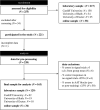Effects of go/no-go training on food-related action tendencies, liking and choice
- PMID: 34457346
- PMCID: PMC8385366
- DOI: 10.1098/rsos.210666
Effects of go/no-go training on food-related action tendencies, liking and choice
Abstract
Inhibitory control training effects on behaviour (e.g. 'healthier' food choices) can be driven by changes in affective evaluations of trained stimuli, and theoretical models indicate that changes in action tendencies may be a complementary mechanism. In this preregistered study, we investigated the effects of food-specific go/no-go training on action tendencies, liking and impulsive choices in healthy participants. In the training task, energy-dense foods were assigned to one of three conditions: 100% inhibition (no-go), 0% inhibition (go) or 50% inhibition (control). Automatic action tendencies and liking were measured pre- and post-training for each condition. We found that training did not lead to changes in approach bias towards trained foods (go and no-go relative to control), but we warrant caution in interpreting this finding as there are important limitations to consider for the employed approach-avoidance task. There was only anecdotal evidence for an effect on food liking, but there was evidence for contingency learning during training, and participants were on average less likely to choose a no-go food compared to a control food after training. We discuss these findings from both a methodological and theoretical standpoint and propose that the mechanisms of action behind training effects be investigated further.
Keywords: action tendencies; approach bias; choice; food; go/no-go training; liking.
© 2021 The Authors.
Figures




References
-
- World Health Organization. 2018Obesity and overweight. See https://www.who.int/news-room/fact-sheets/detail/obesity-and-overweight (accessed 24 July 2019).
-
- Hofmann W, Friese M, Wiers RW. 2008Impulsive versus reflective influences on health behavior: a theoretical framework and empirical review. Health Psychol. Rev. 2, 111-137. (10.1080/17437190802617668) - DOI
Associated data
LinkOut - more resources
Full Text Sources

